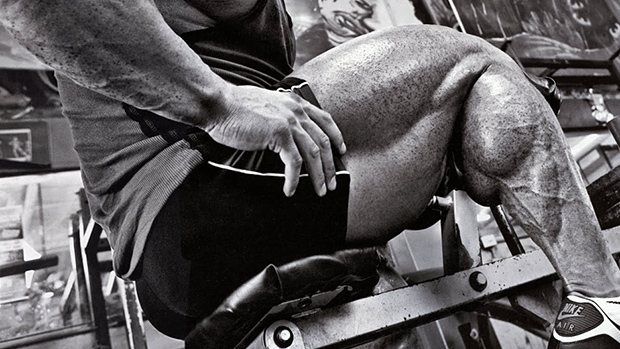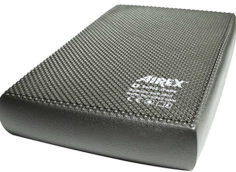I'm sure you've noticed how some guys seem to have muscles that are so full and round that they seem to jump right off their bones, while we mortals have muscles that are visually less voluminous, maybe even flat.
Well, this article is for those of us in the latter group who could use a boost in muscle fullness.
Although we may never be able to match the genetically gifted freaks of fullness like current Mr. Olympia Phil Heath or former almost-Mr.-Olympia Flex Wheeler, we can all significantly, even dramatically, increase the fullness of our muscle bellies by using one or more of the following strategies.
Just to make sure we're on the same page, by time under tension (TUT) we're talking about the amount of time the working muscle is under tension, as in contracting, during a given set.
Whether it's concentric, eccentric, or isometric, muscle contraction increases the tension within a muscle. For purposes of filling out flat muscles, it isn't the TUT itself that's important. Instead, it's the effects of a longer TUT that we're most interested in, specifically, the effect of blood vessel occlusion.
When a muscle is contracting, the blood vessels within it are squished to the point of being occluded, thus dramatically reducing blood flow to that muscle. Think of putting your foot on a garden hose.
The longer the muscle is contracting, the longer the blood flow is stopped. Obviously your heart is still pumping blood during your set, so this occlusion results in more blood volume building up on the upstream side of the working muscle.
Then when your set is completed and the muscle relaxes, blood rushes into the muscle like water rushes into the downstream portion of a suddenly opened dam.
The key here is that the longer the blood is occluded, the higher the volume of blood suddenly surging into the muscle. To literally feel this at work, do push-ups for five seconds and note the pump you get after. Now rest a couple minutes and then do push-ups for 30 seconds, again noting the subsequent influx of blood.
Whether you call it hyperanemic supercompensation or a pump, this sudden surge of blood flow and increased blood volume increases the pressure within the muscle.
As Arnold creatively discusses in the movie Pumping Iron, getting a good pump does feel really cool. However, what we're after is the increase in outward pressure this increase in blood volume places on the tough, dense, fascia that surrounds the muscle.

Make no mistake about it, fascia isn't easy to stretch, but over time it does respond to pressure by expanding and subsequently causing (or allowing) an increase in the volume – and visual fullness – of the muscle it surrounds.
While all of this is certainly rooted in science, what we care about is results...not science. My experience, as well as that of many other bodybuilding-type coaches, has shown that increasing TUT does, in fact, lead to an increase in muscle fullness. It takes time, no doubt, but it does occur.
As Thibaudeau and Waterbury have done a great job of reminding us, using more resistance and a higher rep speed is advantageous in terms of motor unit recruitment (a.k.a. recruiting more muscle fibers).
So instead of prolonging TUT by doing reps more slowly with a lighter weight, it's a better idea to still move the weight quickly (at least concentrically) and to only lighten the weight as much as is needed to increase the TUT to around 45 seconds or so.
If a set takes less than 30 seconds, it's not going to be optimal in terms of increasing intramuscular pressure. On the other hand, going longer than 60 seconds isn't generally optimal either, because it requires using a weight that is too light. Shooting for a TUT of about 45 seconds seems to be the sweet spot.
Our body is an amazingly adaptive biological 'machine' of sorts. It does its best to respond to everything we throw at it by adapting and coming back even more ready to tackle that particular task. Doing a high volume training session is no exception.
By volume we're talking the combination of sets and reps. In essence, it's the overall amount of work a muscle does during a workout. More work means more energy is needed to fuel that work. When we're talking fuel for muscle contraction, we're talking muscle glycogen...the stored carbs within a muscle.
Let's say you're going to apply the above fascial expansion rule-of-thumb and do sets of, for example, twelve reps during your chest workout. Doing 10 sets of 12 reps uses far more pectoral glycogen than does doing just two sets of 12. (Keep in mind that glycogen comes from the muscle being worked.)
A neat thing happens when we do a training session with enough volume to deplete muscle glycogen within a muscle. The body responds by trying to store more muscle glycogen in that muscle so that you're better able to handle the same workout the next time around.
The short-term increase in muscle glycogen is called glycogen supercompensation. This results in your muscles temporarily being able to store more glycogen than they could normally hold – say 120% vs. the normal 100%.
In the long run your body is still working to gradually build the capacity to store more glycogen, and it will if you keep taxing glycogen stores. So this increase in muscle glycogen is both a short-term and long-term strategy.
Although we're not arbitrarily concerned about more intramuscular glycogen storage, we are concerned about muscle fullness. And a muscle that stores more glycogen is a rounder, fuller, muscle.
As with any training adaptation, this isn't something you'll necessarily see after a high volume workout or two. But it is something you'll certainly notice over time.
In my experience, after training in a high-volume manner for about eight weeks you should see some new and improved fullness to your muscle bellies... well, the ones subjected to high volume training, that is.
There are a couple of exceptions, however. If you've already been using a relatively high volume of training, then you're not going experience as much, if any, adaptation, simply because you've already been doing it. The same applies to increasing TUT, by the way.
The other reason you may not see and experience the muscle fullness that you should isn't training related, it's diet related. If you don't consume enough carbs, especially in the post-workout window of increased sensitivity to glycogen storage, then your body simply doesn't have the fuel with which to fill your muscles up with glycogen.
Remember, glycogen is simply stored carbs, not stored protein or fat. Just like you have to put gas in to refuel your vehicle's gas tank, you've gotta put ample carbs in your body to fully replenish muscle glycogen stores.
It's worth pointing out that, as you would imagine, if you're chronically storing more glycogen within the muscle, the surrounding fascia is also receiving the oh-so-important pressure to stretch. And over time it will.
Again, this strategy is supported by lots of anecdotal evidence. But you must keep in mind that volume and intensity simply must be inversely proportional to allow for complete muscular and nervous system recuperation. So, avoid the temptation to take every set of a high volume program to failure.
Similar to the first strategy, optimizing rest periods between sets relates to maximizing blood volume and pressure within the muscle.
Imagine doing a killer set that really has you pumped to the max, feeling like your skin is going to tear at any moment. Now let's say you decide to rest 3 minutes in order for your body to remove lactic acid, buffer hydrogen ions, and replenish creatine phosphate (CP) stores as much as possible. In terms of performance on the upcoming set, this is a great idea.
But in terms of sustaining the increase in intramuscular blood volume, resting 3 minutes is not a good idea. You can probably feel your imaginary pump fading just thinking about resting 3 minutes.
Remember, fascia is a tough, dense type of tissue. It doesn't just expand because a little pressure is put on it for a few moments. Instead, it takes copious amounts of sustained pressure to eventually get it to expand.
So in order to maximize fascial expansion and muscle fullness, once you've got a muscle full of blood, you wanna keep it full of blood for as long as possible. Doing so provides more of a stimulus for fascial expansion.
As with every technique, there are pros and cons. If you resume your next set too soon, your performance on the following set will suffer. As mentioned above, it does take time to clear waste products and replenish CP stores, both of which are important if you plan to get a decent number of reps on the following set.
On the other hand, rest too long and you're going to release the outward pressure on the fascia.
This is certainly a time when paying close attention to your body will come in handy. By paying close attention to the tightness and fullness after a set and, especially, when that fullness begins to dissipate, you can finely tune your rest periods to optimize fascial stretch.
Also take note – as in literally in a notebook/training log – of your performance on the next set. If you get 15 reps on set one but only six reps on set two, then you didn't rest long enough.
If you combine your attentiveness to the dissipation of intramuscular pressure with your performance on subsequent sets, you can finely tune your rest periods for fascial expansion better than I could prescribe a specific rest interval.
With that being said, if you're like me and sometimes just wanna stick to a given rest period without occupying your mind with such details, then go with a rest period of about 45 seconds. Thirty to sixty seconds is a good range to stay within. Generally err toward the lower side on less taxing things like biceps curls, and toward the longer end on more taxing movements like squats...that is if you're ever feeling froggy enough to try squats with just 60 seconds of rest.
No, I'm not talking about timing your stretching so that's it's done after a big meal, I'm talking about stretching a muscle while it's full of blood.
Let me preface this by saying that I highly encourage you to stretch ANY time. Stretching is one of the most undervalued tools we have available to us, both in terms of performance and injury prevention, as well as appearance.
Plain 'ol stretching itself helps to reduce the constrictive force fascia puts on muscle. And it's especially effective in terms of fascial expansion if it's held for a longer period of time. Think longer TUT for stretching, too.
In order to maximize the expansive force placed on the surrounding fascia during a stretch, do the stretch while that muscle is still full of blood. In other words, stretch within 30 seconds of completing a high TUT set. Then, as opposed to your typical ten-second stretch, hold the stretch for a while. Shoot for more like 60 seconds, or even more.
Because static stretching appears to decrease power (and probably strength) on subsequent sets, plan to do this long-hold stretching after completing the last set for that particular body part.
There's also another benefit to stretching in regards to muscle fullness other than putting tension on and expanding the fascia. It appears that if done with ample tension and duration, stretching actually stimulates the muscle to lengthen by laying down new sarcomeres.
If, in fact, we can get a muscle to add length via new sarcomeres, then that muscle will have more overall volume and will appear fuller, especially when flexed.
The results I've seen with stretching a body part immediately after training it while still full of blood have really surprised me. It works very, very well, not only in terms of muscle fullness, but also in terms of enhanced visual striations, especially in the chest (assuming one is lean enough).
(My theory in regards to more visual striations after implementing a stretch-when-full program is this: as the fascia expands, it's not putting as much of a compressive effect on the muscle, thus allowing the already-present striations to show through more clearly. In other words, a tight fascia reduces the appearance of striations because it flattens them out, so-to-speak.)
But as with any of these techniques that rely on fascial expansion, it takes time and consistency. Make yourself a reminder in your logbook to stretch after training or you'll forget. And plan on at least 3 months of implementation before seeing changes. If you're patient enough to implement this strategy for 6 months, I have no doubt you'll see benefits.
The fifth and final training strategy we're going to discuss results in fuller muscles not via expansion of fascia, but rather by placing training stress precisely where it belongs...on the target muscle.
When it comes down to it, the whole point of training is to stress the body, then let it adapt. In terms of bringing up a weak or flat muscle, we must ensure that the stress of training is placed right on that muscle. That's the only way to ensure it's the one that will adapt.
For example, let's say you're doing barbell bench press to fill out your pecs. If, for some reason, your triceps end up doing the brunt of the work, then it's your triceps that will get bigger and stronger...not your pecs.
Staying with this example, there are a couple of ways to ensure that the pecs do the work and receive the stimulation, as opposed to the triceps. One way is to isolate the pecs with another exercise immediately prior to doing the compound, multi-joint bench press.
For example, do dumbbell flyes first, then immediately go into the barbell press. The lighter weight you will use on the bench press is humbling, to say the least. But you can rest assured that it's your pre-exhausted pecs that are the weak link during the barbell press. Thus your pecs, as opposed to your triceps, will be the muscle that's forced to adapt via hypertrophy.
In addition to pre-exhaustion or pre-isolation, simply doing isolation exercises themselves is perfect for filling out a weak muscle.
As a general rule, it's better to err toward compound movements like squats, deadlifts, and the aforementioned bench press. But when it comes to improving a specific body part, isolation exercises like leg extensions, straight-arm pulldowns, and flyes are often just what you need.
Isolation exercises aren't optimal for improving overall strength, but they help fill out a lagging body part by placing all of the stress of that exercise on that particular body part. Again, think flyes vs. presses, or leg extensions vs. squats.
If you have a hard time feeling a particular muscle work during a compound movement that really should hit that muscle well, then try doing the isolation exercise first, before moving on to the compound exercise. Not only does this provide a bit of pre-exhaustion similar to when they're done in a superset fashion, but it also works by neurologically warming up (or waking up) this otherwise hard-to-target muscle.
As an example, let's say you have a hard time feeling your upper back (i.e., mid traps, rhomboids) work while doing overhand barbell rows. Try doing reverse flyes as your first exercise. Then move on to rows. You'll find that you'll feel your upper back much better on the rows than if you did them first.
I really hope you benefit from some of these strategies. Just make sure to keep in mind that improving your physique, especially bringing up a stubborn, flat body part does indeed take time. So have patience and enjoy the journey.





